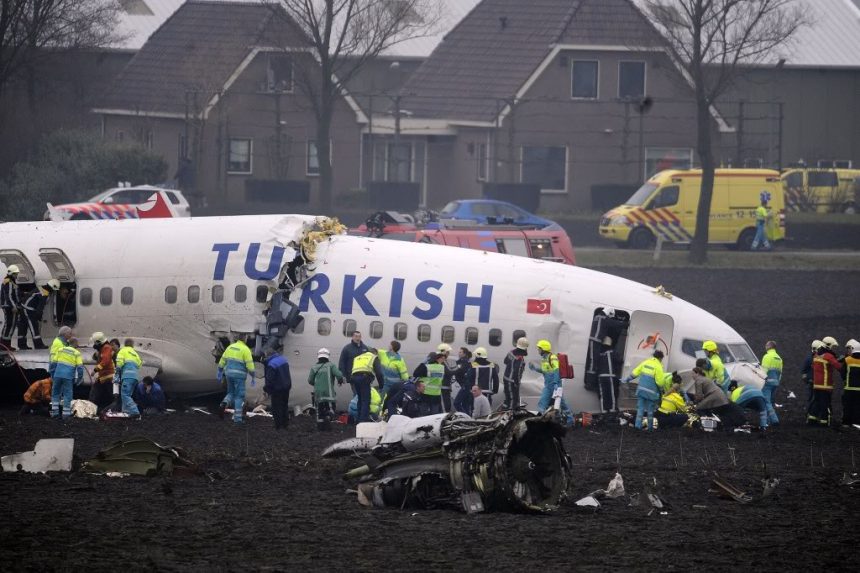On Feb. 25, a Turkish Airlines B737-800, “TC-JGE”, flying as TK1951 from Istanbul to Amsterdam with 127 passengers and 7 crew members, crashed shortly before landing on RWY 18R at Amsterdam’s Schiphol International airport right around 10.35LT. As a result of the impact, the airframe broke into three main parts: 9 people (comprising Captain and First Officer) died and 50 were injured.
Obviously, there are lot of possible reasons why the airplane crash landed where it did (fortunately, in an isolated area). Basing on the details which have surfaced so far it is possible to try to theorize the root causes of the accident and to explain why media is reporting many different scenarios:
1) from the picture released so far, there’s no evidence of fire, just like the aircraft ran out of fuel before crashing (it would be coherent with the fact that someone saw the aircraft “gliding”). However it was reported that the B738 was fully loaded with fuel at the departure
2) a few witnesses standing or driving on the nearby highway said the airplane was flying slow at low altitude when, suddenly, the tail went down and the nose up. After pilot correction, the airplane flew horizontally again before it pitched down into the field. Many reported as the aircraft fell like a brick from the sky (it most probably stalled).
3) wind shear could be a possible cause, even if no other aircraft reported it. The METAR at the time of the crash was: EHAM 251025Z 22011KT 3500 -DZ BR OVC007 05/04 Q1027 TEMPO 2500 that is to say wind from 220 at 11 knots, 3500 meters of visibility, overcast at 700 feet, drizzle, mist, temperature 5° C, dew point 4° C, pressure 1027 millibars. Nothing special for Schiphol. Experiencing wind shear crew members would select TOGA (Take Off / GO Around) thruust to avoid falling into the ground while witnesses saw the aircraft touching the ground with low energy and pictures of at least one of the engine show the compressor’s blades in good shape, meaning that the engine was windmilling / low regime.
4) right engine separated from the wing and rested some hundred meters apart from crash location (slightly ahead of the B737). Someone speculated one engine separated from the aircraft during landing but in this case it would have fallen somewhere behind the wreckage location. If one engine separated at AMS it would be the second time an in-flight engine separation takes place in the same location. In 1992 a LY B747-200 crashed into the houses during night approach at Schipol. Aviation disasters some times have the habit of coming up with strange coincidences.
5) double flame out caused by multiple birdstrike will be investigated (but it seems unlikely to me, since it would be the third occurrence in a few months). But I don’t think the pilot would have reacted to such an emergency by
6) the aircraft declared an emergency for engine(s) problem. This is somehow strange: if the aircraft had a catastrophic failure that brought to a rapid stall, there would (probably) be no time to radio a Mayday or to declare an emergency. The famous rule “Aviate, Navigate, Communicate” always applies. In this case, looks like the pilots were not able to fly the aircraft, so they would not even think to communicate.
This accident and what has been reported so far by the media reminded me of the British Airways 038 crash landing in London Heathrow. In that case as I explained here) as I watched an amateur video of the B777 I explained: “Looking at this video, it appears that the B777 is trying to keep the glideslope while speed is decreasing.
The aircraft has, in fact, an unusual pitch attitude, probably induced by the autopilot that is raising the AOA (Angle Of Attack) to maintain the ILS to compensate insufficient thrust, under deteriorating speed conditions. Very dangerous attitude (especially) at 600ft that made the aircraft get less horizontal distance, thus touching short of the runway 27L”. What if the Turkish Boeing 737 ran out of fuel (or experiencing insufficient thrust because of a birdstrike, autopilot problem, bad data input, or for any other reason, separation comprised) while performing the approach? The autopilot would have raised the nose to keep the ILS and the aircraft would near stall conditions very quickly. It is to avoid such a dangerous situation that as soon as a failure of one or two engine is detected the crew has to shut off autopilot and autothrottle and to apply TOGA to prevent stall.
The following pictures released to the media show the wreckage of the aircraft:











